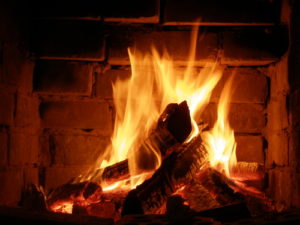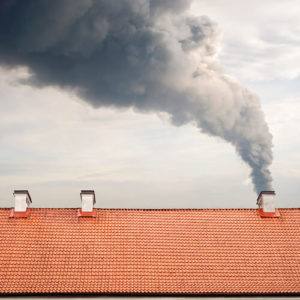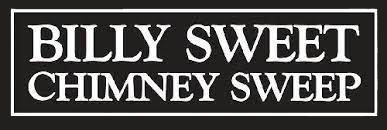by Billy Sweet | Feb 19, 2019 | Creosote
Many homeowners across the U.S. have been using their fireplaces for several weeks. In that time, the fires have produced soot consistently, and wood fires produce creosote as well. Every fire that burns wood will produce creosote because it is a natural byproduct, but how much creosote is produced will depend on the type of wood you burn.
The Problem with Creosote
Creosote can be no problem as long as it’s cleaned on a regular basis. When cleaned regularly, creosote can be removed safely by a professional using brushes and a vacuuming system during a routine chimney sweep. When these important services are neglected, the sticky creosote can buildup and lead to an obstruction that slows down the air in the chimney system. When homeowners continue to use a dirty system, the airflow slows significantly and the high temperatures cause the creosote to boil and the water in it to evaporate. Once the water evaporates, what is left is a dense, hard mass of concentrated tar–a highly flammable material left right in the line of fire.
Glazed Creosote
A level three creosote buildup is called “glazed creosote” because the creosote takes on a hardened, shiny look after repeated heating and cooling. As the creosote problem worsens, the airflow slows and heated air lingers in the flue, raising the risk of flue fire. When glazed creosote ignites, it results in an intense, fast burning fire that expends a large amount of gas and energy. This burst of energy can crack the flue liner, damage the masonry, and spread to other parts of the house. Other times a flue fire can occur and a homeowner won’t even notice. It’s important to schedule a chimney inspection if you suspect a flue fire. The first flue fire may damage the system, and a second flue fire can travel through damaged masonry to the rest of the house.
Glazed Creosote Removal
Soot and creosote is easily removed during a routine chimney sweep. Glazed creosote, however, cannot be removed using the same methods. Some amateurs may attempt to remove the creosote by prying it away, but this never removes it completely and even leaves scratches and other damage to the liner. Hire a professional who knows the safe and proper methods for glazed creosote removal. At Billy Sweet Chimney Sweep we use industrial products to safely remove glazed creosote without leaving any damage to the system. This trusted product can be sprayed or wiped onto the glazed creosote. As it’s absorbed, the creosote flakes away and can be swept away and collected just like soot.
Prevent Creosote Buildup
You can prevent a dangerous and dirty chimney system by scheduling professional services annually and using your system properly.
-Schedule routine chimney sweeps to clean the flue of soot and creosote before a buildup occurs.
-Burn only properly seasoned wood. Green or fresh wood produces more creosote while burning.
-Schedule chimney inspections annually so you can rest assured your system is working properly and the wood is burning completely.
-Pay attention to signs such as flakes in the fireplace or slick, black material on the masonry.
Schedule services with the licensed professionals at Billy Sweet Chimney Sweep today. Call 617-469-4528 or schedule online.
by Billy Sweet | Aug 30, 2018 | Creosote, Uncategorized
To say creosote is a minor problem would be an understatement. Creosote is neither rare nor harmless. Every wood-burning fire that you burn in your fireplace and chimney system produces smoke that rises up the chimney. The smoke is filled with hot gases, particles, soot, and creosote that covers the chimney interior. Though soot can be corrosive to the chimney liner and masonry, creosote presents a whole different set of problems.
Creosote Buildup
Soot is made up of carbon, but creosote is made up mostly of tar–a sticky substance that is also flammable. Because of the sticky nature of creosote, it collects easily in a chimney, covering parts, clogging the clean out area, and creating a fire hazard. As the creosote builds up, it can become a serious obstruction–and when it reaches stage 3 buildup it is also difficult to remove.
Stage 3 Creosote
Stage 3 creosote, also called glazed creosote becomes a problem only when the chimney isn’t cleaned regularly. When the creosote isn’t removed on a regular basis, it builds up. When it becomes heated, the creosote boils, causing all the moisture in it to evaporate, and leaves a hardened mass of condensed fuel in the flue. Once it reaches this stage, the creosote can’t be brushed away during a standard chimney sweep. It decreases the chimney’s efficiency, increases the amount of creosote produced by the inefficient fire, and raises the risk of flue fire.
Chimney Damage
Creosote will not damage the chimney when it is cleaned regularly and properly. Once creosote reaches stage 3 buildup it can be difficult to remove without damaging the liner. You cannot remove it with brushes and a homeowner or handyman attempting to do so with tools will cause damage. Additionally, if it isn’t removed, the glazed creosote can cause a creosote fire that damages the masonry, the liner, and even the structure of the chimney. If you suspect a flue fire, you should call a chimney professional for an assessment right away.
Prevent Creosote Buildup
You cannot stop creosote altogether, but you can prevent dangerous buildups.
Schedule Regular Chimney Sweeps – Your chimney sweep appointments will keep your chimney working properly and the chimney professional will assess it with each appointment.
Burn Properly Seasoned Wood – Burning wet or “green” wood that is freshly cut will drop the efficiency of your fireplace. Green wood is harder to light and burns with less heat, often burning incompletely. This leads to more creosote. Burn only properly seasoned firewood in your fireplace to keep your chimney system working properly.
When you do have a creosote buildup in your chimney, it’s important to call the professionals for proper and safe removal. Billy Sweet Chimney Sweep technicians use an industrial product to remove the creosote without damaging the liner and then we clean the entire flue.
Give us a call before you try to remove creosote yourself. It’s harmful to breathe, may irritate your skin, and can destroy your flue if it results in a fire.
Talk to a professional today at 617-469-4528.
by Billy Sweet | Dec 26, 2015 | Creosote
If you have a fireplace, you likely know that creosote can be a hazard to your home and family. You probably also have your fireplace swept by a certified chimney sweep each year to remove any creosote buildup from your chimney, and perhaps you even burn the occasional creosote sweeping log to help maintain your chimney. But how much do you know about creosote, how it forms, the dangers it poses and how you can keep it at bay? We’ve put together some basic information on creosote so you can better protect your home and family.

What is creosote?
As smoke from your fireplace makes its way to the top of your chimney, it cools. As the smoke cools, it causes condensation of the chemicals and water vapor created when wood burns. The substance left sticking to your walls is creosote. All forms of creosote — whether black or brown, sticky or shiny, hard or tar like — can be found sticking to the insides of most chimneys.
Why is creosote dangerous?
As little as a quarter inch of creosote buildup on the walls of your chimney can be dangerous, putting your home at risk of a chimney fire. Highly combustible, creosote can burst into flames if it is touched by a stray spark from your fireplace, or if chimney temperatures exceed 1,000 degrees. If creosote builds up enough in your chimney, it also can prevent the gases created by the fireplace from exiting your home, which can force dangerous carbon monoxide back into your home.
How can I avoid the dangers of creosote?
Using the right wood in your fireplace can slow the buildup of creosote in your chimney. Only burn dry hardwoods that have been seasoned for a minimum of six months. When wood is improperly seasoned and contains moisture, it produces more water vapor when burned and burns at a cooler temperature, which causes the formation of creosote. Make sure that your fire is large enough for your fireplace. If your logs are too small, the fire won’t burn hot enough for your chimney. Your flue also should be fully opened when you’re burning a fire, as a partially closed flue will cause smoke to remain in your flue longer, encouraging creosote buildup.
Of course, the best way to keep your home safe from a creosote fire is to have your chimney swept and inspected each year by a certified chimney sweep. Your chimney sweep will make sure that your chimney is entirely creosote free. During the sweep’s inspection, he also will make sure your chimney does not show any signs of damage from a past creosote fire, which can weaken your chimney and put your home at danger for a future fire.
If you’re overdue for a chimney sweeping and inspection, don’t wait! Putting off your chimney sweeping puts your home and family in danger of a creosote-caused chimney fire or carbon monoxide poisoning. Call the certified sweeps at Billy Sweet to have your chimney ready for the fire-burning season.



